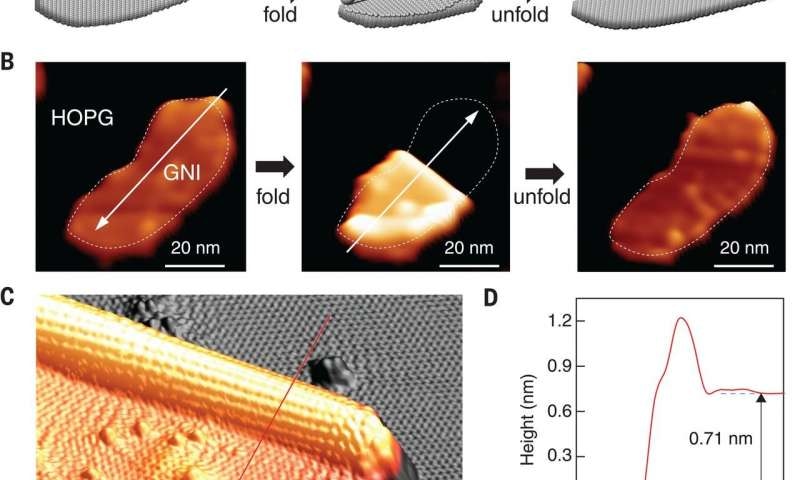Sep 17 2019
A team of researchers from the Chinese Academy of Sciences, Vanderbilt University and the University of Maryland has created origami-like structures made out of graphene using scanning tunneling microscopy. In their paper published in the journal Science, the group explains how they achieved this feat and possible applications.
 Construction of atomically well-defined folded GNSs by STM origami. (A) Schematic graphic of folding and unfolding a GNI along an arbitrary direction (black arrows). (B) Experimental realization of (A). The series of STM images shows a sequence of the folding and unfolding of a GNI along the direction indicated by the white arrows. HOPG, highly ordered pyrolytic graphite. (C) 3D STM topography of a typical folded GNS. (D) Line profile along the red arrow in (C) showing the formation of both the 1D tubular edge and the 2D stacked graphene flatland with height comparable to the distance between two graphene layers (0.70 nm). Settings for (B): tunneling current It = 10 pA; bias voltage Vs = −3 V. Settings for (C): It = 100 pA; Vs = 1 V. The GNIs were manipulated by using lateral tip-induced manipulation with a typical current of ~100 pA and a voltage of ~3 mV. All results were acquired at temperature T = 4.2 K. Credit: Science (2019). DOI: 10.1126/science.aax7864
Construction of atomically well-defined folded GNSs by STM origami. (A) Schematic graphic of folding and unfolding a GNI along an arbitrary direction (black arrows). (B) Experimental realization of (A). The series of STM images shows a sequence of the folding and unfolding of a GNI along the direction indicated by the white arrows. HOPG, highly ordered pyrolytic graphite. (C) 3D STM topography of a typical folded GNS. (D) Line profile along the red arrow in (C) showing the formation of both the 1D tubular edge and the 2D stacked graphene flatland with height comparable to the distance between two graphene layers (0.70 nm). Settings for (B): tunneling current It = 10 pA; bias voltage Vs = −3 V. Settings for (C): It = 100 pA; Vs = 1 V. The GNIs were manipulated by using lateral tip-induced manipulation with a typical current of ~100 pA and a voltage of ~3 mV. All results were acquired at temperature T = 4.2 K. Credit: Science (2019). DOI: 10.1126/science.aax7864
For several decades, scientists have sought to fold sheets of graphene in controllable ways. While some managed to fold sheets of graphene, they were either not able to do it in a controlled way, or they had to pretreat the graphene to make it bend in certain places. Scientists believe that if graphene sheets could be manipulated controllably, the resulting materials would have desired properties—one example would be bending it at a "magic angle" to make it superconductive. Others hope to develop smaller processors than can be made using silicon. In this new effort, the researchers claim to have found a way to fold nanoislands of graphene controllably.
The first step involved creating the nanoislands of graphene. The researchers fired hydrogen ions at sheets of graphite for 10 cycles, a process that took 10 hours. This produced high-quality graphene that could stand up to manipulation without breaking or bending in unreliable ways. After that, the team used a scanning tunneling microscope (STM) to grab parts of the nanoislands and then to hold onto them as the sheet was folded, much like a piece of paper. They note that it took some expertise on the part of the person controlling the STM to manipulate the sheets accurately.
The team demonstrated their technique by first attaching carbon nanotubes to one of their nanoislands, and then folding it in half like an omelet. They went on to fold other tiny sheets into basic origami shapes. They acknowledge that their technique is quite cumbersome at present, and that more work is required before it could be used to create commercial products.